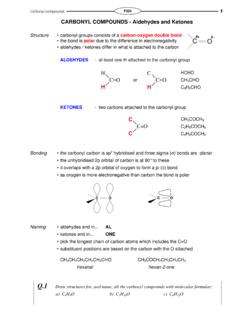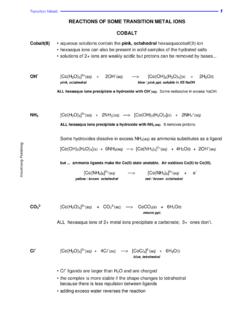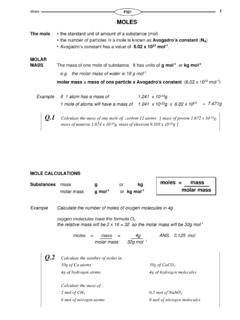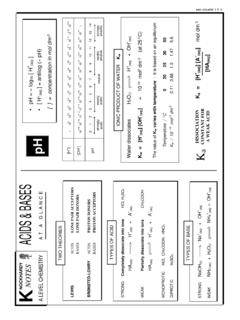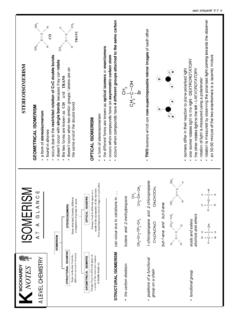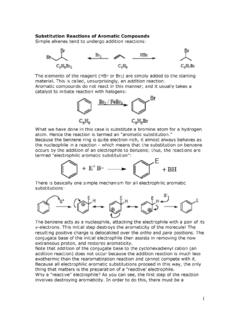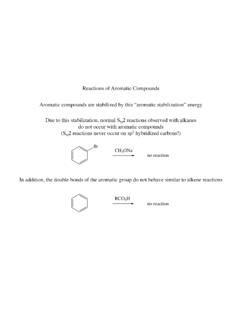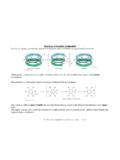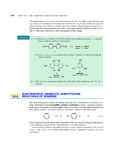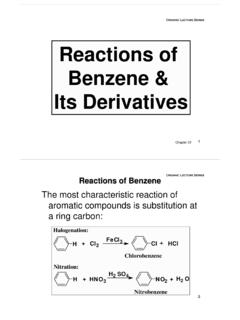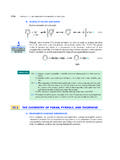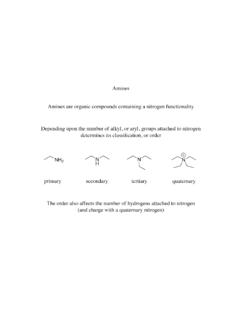Transcription of Aromatic compounds F324 - knockhardy.org.uk
1 BENZENES tructurePrimary analysis revealed benzene had empirical formula of CH and amolecular formula of C6H6 KekuleKekul suggested a PLANAR, CYCLIC structure with ALTERNATING DOUBLE AND SINGLE BONDS However it did not readily undergo electrophilic addition - no true C=C bond only one 1,2 disubstituted product you didn t get two isomers like all six C C bond lengths were bonds are shorter than single ones NOT the ring was thermodynamically more stable than expected - see belowTo explain the above, it was suggested that the structure oscillated between thetwo Kekul forms but was represented by neither of them - a resonance compounds 1F324 KNOCKHARDY SCIENCE out some suitable structures which fit the molecular formula C6H6 DelocalisedThe theory suggested that instead of three localised (in one position) doublesystembonds, the six (pi) electrons making up those bonds were delocalised (not inany one particular position) around the ring by overlapping the p orbitals.
2 Therewould be no double bonds to be added to and all bond lengths would be equal. Italso gave a planar structure. 6 single bonds one way to overlap another delocalised pi adjacent p orbitals possibility orbital systemThis structure was particularly stable andresisted any attempt to break it down throughnormal electrophilic addition. However, overallsubstitution of any of the hydrogen atoms wouldnot affect the delocalised system. Thermodynamic evidence for stabilityWhen unsaturated hydrocarbons are reduced to the corresponding saturated compound ,energy is released.
3 If the experiment is carried out in a bomb calorimeter the amount of heatliberated per mole (enthalpy of hydrogenation) can be cyclohexene (one C=C bond) is reduced tocyclohexane, 120kJ of energy is released per (l) + H2(g) > C6H12(l)Theoretically, if benzene contained three separateC=C bonds it would release 360kJ per mole whenreduced to cyclohexaneC6H6(l) + 3H2(g) > C6H12(l) benzene releases 208kJ per mole when reduced putting it lower down the energy scale it is 152kJ per mole more stable than expected. this value is known as the resonance Aromatic compoundsF324 KNOCKHARDY SCIENCE 2008152 kJ mol 1- 120 kJ mol 1H=- 360 kJ mol 1H=theoreticalexperimental- 208 kJ mol 1H=more stable thanexpectedCCCCCCCCCCCCCCCCCCHREACTIONS OF THE BENZENE ( Aromatic ) RINGN itration Converts benzene into nitrobenzene, C6H5NO2 The nitration of benzene is the first step in an historically important chain ofreactions.
4 These lead to the formation of dyes, and nitric acid and conc. sulphuric acid (catalyst)conditionsreflux at 55 CequationC6H6 + HNO3 > C6H5NO2 + H2 Omechanism an electron pair leaves the delocalised system to form a bond to the electrophile this disrupts the stable delocalised system and forms an unstable intermediate. to restore stability, the pair of electrons in the C-H bond moves back into the ring. overall there is substitution of hydrogen .. ELECTROPHILIC SUBSTITUTION electrophileNO2+ , nitronium ion or nitryl cationit is generated in an acid-base reaction as + HNO3 2 HSO4 + H3O+ + NO2+ acid baseproton protondonoracceptorImportanceNitrobenzen e is the start of an important chain of reactions .
5 Nitrobenzene phenylamine benzene diazonium phenol (aniline)chlorideAromatic compounds 3F324 KNOCKHARDY SCIENCE 2008H++NO2+NO2 HNO2+NO2NH2OH+N2Cl Halogenation Converts benzene into chlorobenzene, C6H5 Clreagentschlorine and a halogen carrier (the catalyst)conditionsreflux in the presence of a halogen carrier such asiron, iron(III) chloride, iron(III) bromide, aluminium chlorideequationC6H6 + Cl2 > C6H5Cl + HCl mechanism PROBLEMC hlorine is non polar so is not a good electrophile.
6 A catalyst (HALOGEN CARRIER) is required to polarise the halogen. anhydrous aluminium chloride can act as the catalyst the Al in AlCl3 has only 6 electrons in its outer shell; - LEWIS ACID it increases the polarisation of the Cl-Cl bond this makes the charge on C more positive and the following occurs Cl2 + AlCl3 AlCl4 + Cl+ the H+ ion removed from the benzene ring reacts with the AlCl4 ion to regenerate the AlCl3 H+ + AlCl4 > AlCl3 + HClComparisonThe conditions are much tougher than with alkenes because thewith alkenesdelocalised system makes benzene more stable and less Aromatic compoundsF324 KNOCKHARDY SCIENCE
7 2008H++Cl+ClHCl+AlClClClAlClClClClClClCl +-The aluminium chlorideacts as a LEWIS ACIDas the aluminium atomhas only 6 electrons inits outer shell. It acceptsa pair of electrons fromone of the atoms in thechlorine the atoms in thenew species havecomplete outer shells The new specieshas 6 electronsin its outer has one lesselectron than achlorine atom sohas a + charge.
